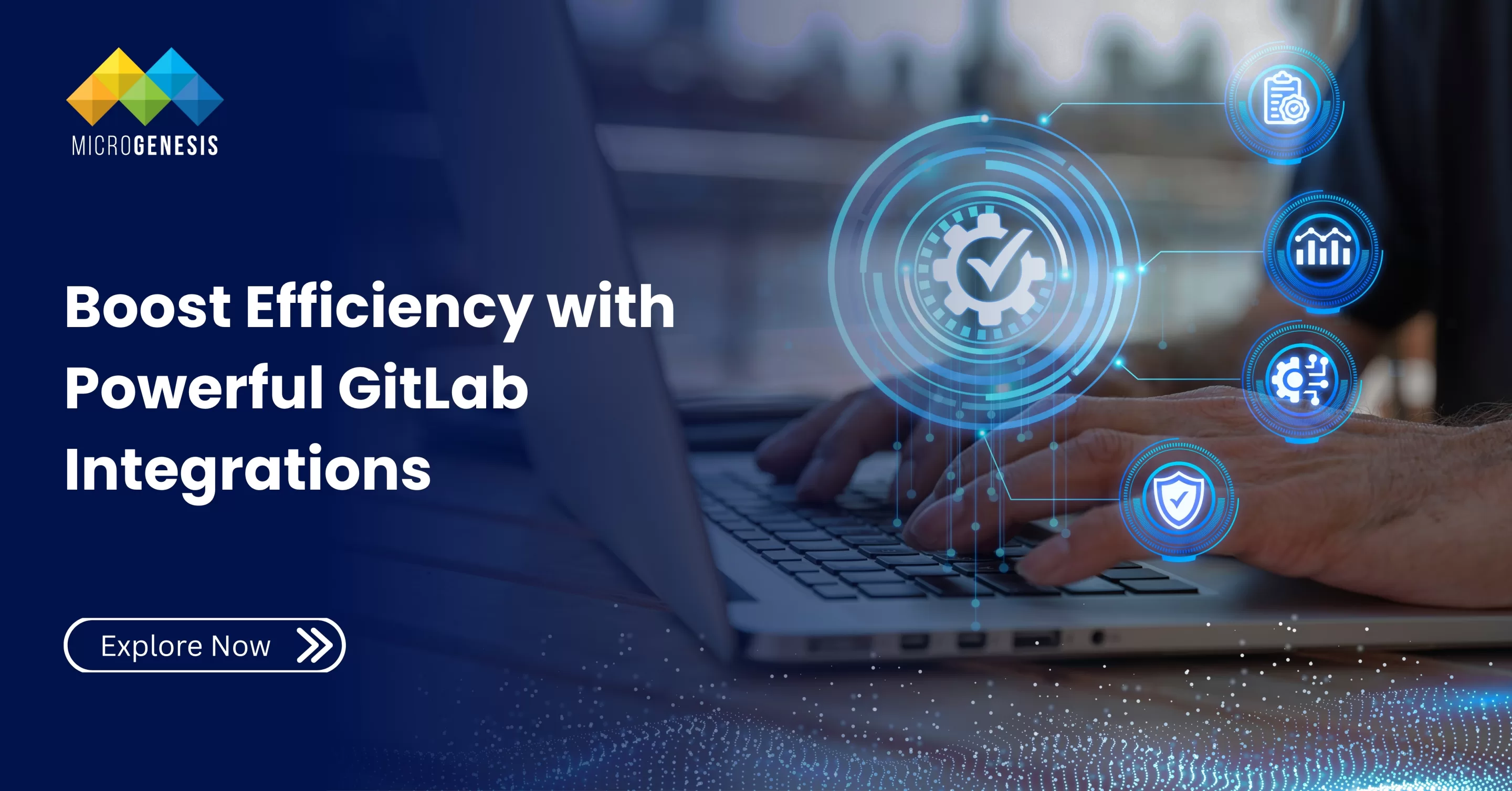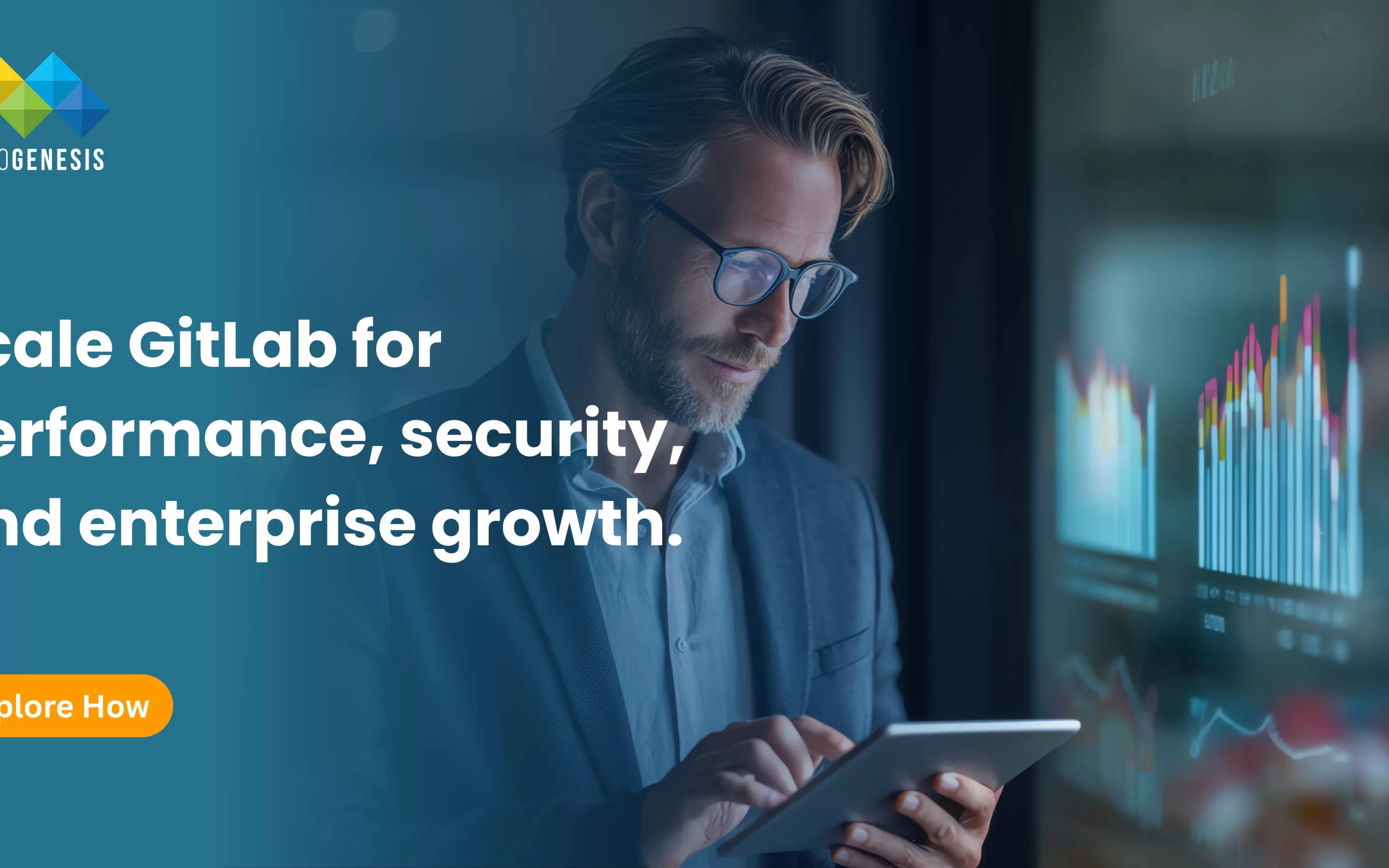Modern enterprises operate in a world where software delivery drives competitive advantage. Teams must build, test, secure, and release applications faster than ever — but with quality and compliance intact. Unfortunately, most organizations still rely on disconnected toolchains: one system for source control, another for CI/CD, and separate platforms for security and collaboration.
This fragmentation leads to inefficiency, lack of visibility, manual errors, and higher costs.
GitLab solves this by providing a single DevSecOps platform that seamlessly integrates with a wide ecosystem of third-party tools — cloud platforms, communication systems, monitoring dashboards, and security solutions. When properly implemented, GitLab’s integrations transform isolated processes into a unified, automated, and intelligent delivery pipeline.
This guide explores how to design, implement, and optimize GitLab integrations to build an efficient, scalable, and secure DevOps toolchain — supported by expert DevOps services, best practices, real-world examples, and governance strategies.
1. The Importance of Integrations in Modern DevOps
1.1 The Era of Connected Development
In modern enterprises, software delivery involves multiple disciplines — developers, QA engineers, security analysts, and operations specialists. Each function uses its own tools:
Developers write code in Git repositories.
QA teams execute automated tests.
Operations deploy and monitor applications.
Security ensures compliance through scans and audits.
When these tools don’t communicate, the result is silos. Data has to be manually shared, reports duplicated, and pipelines orchestrated across disparate systems.
For example, a developer may push code to GitHub, but Jenkins runs the build, SonarQube checks quality, Jira tracks issues, and Slack sends notifications. If one tool fails or data mismatches, diagnosing the issue becomes time-consuming.
Integrations eliminate this friction. With GitLab acting as a central orchestration hub, you can automate these interactions. When a developer commits code, GitLab triggers builds, runs tests, performs security scans, and updates Jira automatically — without human intervention.
The result? Faster cycles, fewer errors, and a synchronized workflow from commit to production.
2. Categories of GitLab Integrations
GitLab supports hundreds of integrations across different technology domains. These integrations allow organizations to build modular, tailored pipelines that align with existing infrastructure while gaining the benefits of GitLab’s unified visibility.
Partnering with an experienced DevOps service provider like MicroGenesis helps organizations design, implement, and optimize these integrations — ensuring seamless workflows, improved collaboration, and faster delivery across the development lifecycle.
2.1 Cloud Platform Integrations
Cloud integrations allow organizations to automate deployments, manage infrastructure, and scale dynamically. GitLab integrates natively with major platforms such as AWS, Microsoft Azure, and Google Cloud Platform (GCP).
AWS Integration Example:
GitLab CI/CD can deploy containerized applications directly to Amazon Elastic Kubernetes Service (EKS) or Elastic Beanstalk. It can also use AWS Identity and Access Management (IAM) for authentication and connect with AWS CloudWatch for monitoring.
A media company, for example, automated its entire deployment to EKS through GitLab pipelines, reducing manual effort by 70% and improving release reliability.
Microsoft Azure Integration Example:
Teams running infrastructure on Azure can integrate GitLab with Azure Active Directory (AD) for single sign-on, and deploy code to Azure Kubernetes Service (AKS) directly from GitLab pipelines.
Azure Artifacts can also serve as a secure registry for container images built by GitLab CI.
Google Cloud Integration Example:
GitLab integrates with GKE (Google Kubernetes Engine), enabling infrastructure automation and real-time monitoring via Google Cloud Operations Suite (formerly Stackdriver).
For instance, a SaaS company used GitLab + GCP integration to auto-scale environments based on load, cutting infrastructure costs by 25%.
Cloud integrations make GitLab an end-to-end automation hub — from code to infrastructure provisioning.
2.2 Monitoring and Observability Tools
Observability is vital for detecting issues early, understanding performance, and maintaining service reliability. GitLab connects seamlessly with popular monitoring solutions such as Prometheus, Grafana, Datadog, and Elastic Stack (ELK).
Prometheus & Grafana Integration:
GitLab uses Prometheus as its native monitoring system. It automatically captures CI/CD metrics (job durations, runner utilization, failure rates). Grafana visualizes these metrics through dashboards, offering insights into system performance.
Example: A fintech company integrated Prometheus and Grafana to monitor pipeline efficiency. They reduced build time by 30% by identifying bottlenecks through metrics visualization.
Datadog & New Relic:
These tools collect detailed performance metrics, helping correlate application latency with specific GitLab deployments. Teams can trace which merge request introduced performance regressions and roll back if needed.
ELK (Elasticsearch, Logstash, Kibana):
GitLab logs — pipeline runs, API calls, user actions — can feed into ELK for centralized analysis, supporting compliance and troubleshooting.
Integrated observability ensures continuous feedback — not just during builds, but throughout application runtime.
2.3 Collaboration and Communication Tools
DevOps thrives on communication. GitLab integrates with collaboration platforms like Slack, Microsoft Teams, and Mattermost to deliver real-time visibility.
Slack Integration:
Teams can receive instant notifications for pipeline failures, issue updates, or merge approvals. For example, when a developer’s pipeline fails, GitLab sends a message to a Slack channel tagged with the developer’s name and project — speeding up resolution.
Microsoft Teams:
Similar to Slack, GitLab integrates with Teams for alerting and reporting. You can configure adaptive cards that summarize deployment statuses or test results within Teams channels.
Mattermost:
As an open-source alternative to Slack, Mattermost integrates tightly with GitLab for self-hosted collaboration. Enterprises focused on data sovereignty prefer this integration.
Impact Example:
A global e-commerce company integrated GitLab with Slack and Jira. Pipeline alerts and merge requests were shared instantly across channels, reducing average issue response time by 45%.
2.4 Issue Tracking and Project Management
GitLab comes with native issue tracking but also integrates with external systems like Jira consulting, ServiceNow, and Asana for organizations with established workflows.
Jira Integration:
Bi-directional synchronization ensures every GitLab commit, branch, or merge request is linked to a Jira issue. Product managers can view deployment progress directly from Jira dashboards.
Example: A tech enterprise migrated from Jenkins + Jira to GitLab + Jira integration, reducing project tracking overhead by 40%.
ServiceNow:
This integration connects DevOps activities to ITSM processes. A ServiceNow change request can automatically trigger GitLab CI/CD jobs once approved, enforcing compliance in regulated environments.
Asana & Trello:
Lightweight project management integrations allow status updates from GitLab issues to reflect on task boards automatically, maintaining alignment between business and technical teams.
Such integrations create traceability from idea to delivery, bridging project management and execution seamlessly.
2.5 Security and Compliance Integrations
Security must be proactive. GitLab integrates with advanced third-party tools to extend its native DevSecOps capabilities.
Snyk, Checkmarx, Fortify:
Provide deep application scanning beyond GitLab’s built-in SAST and DAST. These tools identify zero-day vulnerabilities, code smells, and insecure dependencies.
Aqua Security:
Integrates container runtime protection and compliance checks directly into GitLab pipelines, ensuring that deployed containers meet corporate security policies.
HashiCorp Vault:
Manages and secures API keys, tokens, and credentials used in pipelines, preventing secret leaks.
Example:
A financial institution integrated GitLab with Vault and Fortify, enabling automated code scanning and secret rotation. This reduced security audit findings by 60% and simplified regulatory reporting.
3. Benefits of Building an Integrated GitLab Toolchain
3.1 Centralized Control and Governance
When all integrations connect through GitLab, enterprises gain centralized visibility over code, pipelines, and infrastructure. Access control, audit logs, and monitoring exist in one place — simplifying governance and reducing compliance risk.
Example: A healthcare company unified its DevOps governance using GitLab’s RBAC and audit capabilities, achieving HIPAA compliance while accelerating deployments by 50%.
3.2 Improved Collaboration Across Teams
Integrations connect previously isolated functions — development, QA, operations, and security — into a single communication ecosystem.
Devs get instant pipeline feedback via Slack.
QA sees automated test results in GitLab.
Ops monitors deployment health through Grafana.
This eliminates information gaps and improves delivery speed.
3.3 Streamlined Automation and Efficiency
GitLab’s integration-driven automation reduces manual steps:
Auto-builds upon code commits.
Auto-deployments after successful tests.
Auto-notifications upon completion or failure.
Automation ensures predictable, repeatable delivery, allowing teams to focus on innovation rather than maintenance.
3.4 Stronger Security and Compliance
By integrating security and compliance tools directly into GitLab pipelines, enterprises can detect vulnerabilities early and enforce policies automatically.
For example, an organization integrating Snyk, Vault, and GitLab’s compliance as code achieved continuous PCI-DSS alignment with no manual audit preparation.
3.5 Reduced Cost and Complexity
Replacing fragmented tools with GitLab as the core orchestration layer cuts costs related to licensing, maintenance, and integration overhead. A unified toolchain requires fewer administrators and delivers faster ROI.
Partnering with expert DevOps consulting services ensures a seamless transition, optimized configurations, and long-term efficiency — helping organizations maximize the value of their GitLab investment.
4. Governance and Compliance in an Integrated Ecosystem
4.1 Role-Based Access Control (RBAC)
Access to integrations must reflect organizational hierarchy. GitLab provides granular RBAC so only authorized users can modify or trigger integrations — minimizing human error and risk.
4.2 Centralized Audit Trails
Every integration, whether a Slack webhook or AWS deployment token, is logged in GitLab’s audit trail. This enables traceability for security teams and simplifies regulatory audits.
4.3 Compliance-as-Code
GitLab allows teams to define compliance policies in YAML format:
compliance:
approvals:
minimum: 2
security_scan: required
This “policy-as-code” approach ensures every pipeline automatically enforces governance, with no manual enforcement needed.
5. Common Challenges and How to Overcome Them
5.1 Integration Overload
Adding too many tools can create complexity.
Solution: Focus on core integrations that align with business outcomes, not every available plugin.
5.2 Version Conflicts
Tool updates can break integrations.
Solution: Maintain a staging GitLab instance for testing version compatibility before production rollout.
5.3 Security Gaps
Each integration introduces an attack surface.
Solution: Use API tokens with least-privilege principles, monitor audit logs, and rotate secrets periodically.
5.4 Configuration Drift
Unmonitored manual changes cause inconsistencies.
Solution: Manage integrations as code (IaC), storing configurations in Git repositories for version control.
6. Measuring Integration Success
To ensure integrations are effective, organizations should measure outcomes across technical and business KPIs.
| Metric | Description | Ideal Improvement |
| Pipeline Success Rate | Percentage of successful builds | 95%+ |
| Mean Time to Detect (MTTD) | Speed of identifying performance/security issues | 30–40% faster |
| Release Frequency | Number of deployments per week | 2–3x increase |
| Collaboration Efficiency | Reduction in manual coordination time | 50% improvement |
| Toolchain Cost Reduction | Consolidation and licensing savings | 25–35% |
By measuring these KPIs, leaders can continuously refine integrations to maximize ROI.
7. The Role of GitLab Consulting Partners
Enterprises often rely on GitLab Partners to architect, implement, and optimize integrations. These partners bring:
Proven migration frameworks
Integration blueprints and templates
Automation for CI/CD, cloud, and observability layers
Compliance enablement for regulated industries
Example:
A multinational insurance firm partnered with a GitLab consultant to integrate AWS, Jira, and Datadog with GitLab. Within six months:
Build-to-deploy time decreased by 55%.
SLA compliance increased to 99.9%.
Cross-team productivity improved by 40%.
Partner expertise bridges the gap between vision and execution.
Learn More: How DevOps Automates Processes in Software Development
8. The Future of GitLab Integrations
8.1 AI-Driven Automation
GitLab’s Duo AI will soon power integrations that predict failures, suggest optimizations, and auto-remediate pipeline issues.
8.2 Self-Healing Integrations
Future integrations will auto-detect broken connections and reconfigure themselves using APIs and intelligent rules.
8.3 Low-Code Integration Interfaces
GitLab will expand drag-and-drop connectors, allowing non-technical users to create automation workflows visually.
8.4 Multi-Cloud and Hybrid Flexibility
GitLab’s growing native support for AWS, Azure, and GCP will enable consistent workflows across multi-cloud environments — essential for enterprise resilience.
Conclusion
A modern enterprise’s success depends on how efficiently its systems communicate. GitLab’s integration capabilities transform isolated DevOps tools into a cohesive, intelligent ecosystem — one where automation, collaboration, and security thrive together.
With MicroGenesis, one of the best IT companies and a trusted GitLab partner, organizations can unlock the full potential of these integrations — streamlining workflows, enhancing visibility, and accelerating innovation across the DevOps lifecycle.
With a well-designed integration strategy, organizations can accelerate delivery, strengthen compliance, and reduce costs — all while improving visibility across teams.
And with the guidance of certified GitLab Partners, enterprises can ensure every integration aligns with business goals, governance standards, and technical excellence.
GitLab doesn’t just connect your tools — it connects your entire digital ecosystem, enabling your teams to build faster, innovate securely, and deliver continuously.




